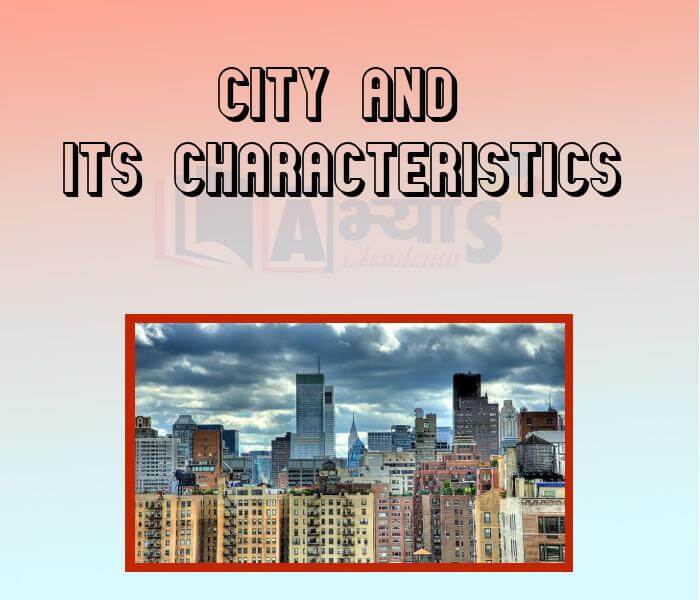City and its Characteristics













City and its Characteristics
In 1880, Durgacharan Ray wrote a novel Debganer Martye Aagaman (The Gods Visit Earth) in which Brahma with other Gods came to Calcutta. Seeing the modern city, they were so impressed that they decided to build a Museum and High Court in Heaven. Calcutta was known as the place of opportunities for trade and commerce, education and jobs in 19th century. On the other side, the city had its own problems also such as - poverty, poor quality of housing, confusion related with religion, casteism and gender identity. Like Durgacharan Ray, many other authors observed the contrasting images and experiences of city, viz., wealth and poverty, splendour and dirt, opportunities and disappointment etc. The modern city worldwide has developed only over the last 200 years. Three historical process which have shaped modern cities are:
1. The rise of industrial capitalism
2. The establishment of colonial rule over large parts of world.
3. The development of democratic ideals.
The present chapter deals with the work, life and leisure of two important cities i.e., London and Bombay.
Characteristics of The City:
Industrialisation and the Rise of the Modern City in England: In modern age, the form of urbanisation has changed due to industrialisation. Most Western countries were largely rural even many decades after the beginning of the Industrial Revolution. The early industrial cities of Britain were Leeds and Manchester. They attracted large number of migrants to the textile mills, set up in the late 18th century. In 1851, more than three quarters of the adults living in Manchester were migrants from rural areas.
What forms of entertainment came up in 19th century England to provide leisure activities for the people?
The following forms of entertainment came up in 19the century England by which the people of all classes entertain themselves
Industrial Expansion in London: By 1750,one out of every nine people of England and wales lived in London.
Over the 19th century in England, London continued to expand. The population of London was about 675000 in 1750. It multiplied four-fold from 1 million in 1810 to 4 million in 1880. According to historian Gareth Stedman Jones, “19th century London was a city of clerks and shopkeepers, of small masters and skilled artisans, of a growing number of semi skilled and sweated outworkers, of soldiers and servants, of casual labourers, street sellers and beggars”. Five major types of industries in London employed a large number of people. These industries were clothing and footwear, wood and furniture, metals and engineering, printing and stationery and precision products such as surgical instruments, watches and objects of precious metal. During the First World War (1914-18), London began manufacturing motor cars and electrical goods and the number of large factories increased in London. This attracted a large number of people to settle there
Students / Parents Reviews [10]
I have spent a wonderful time in Abhyas academy. It has made my reasoning more apt, English more stronger and Maths an interesting subject for me. It has given me a habbit of self studying

Yatharthi Sharma
10thMy experience was very good with Abhyas academy. I am studying here from 6th class and I am satisfied by its results in my life. I improved a lot here ahead of school syllabus.

Ayan Ghosh
8thAbhyas Methodology is very good. It is based on according to student and each child manages accordingly to its properly. Methodology has improved the abilities of students to shine them in future.

Manish Kumar
10thOne of the best institutes to develope a child interest in studies.Provides SST and English knowledge also unlike other institutes. Teachers are co operative and friendly online tests andPPT develope practical knowledge also.

Aman Kumar Shrivastava
10thIt was good as the experience because as we had come here we had been improved in a such envirnment created here.Extra is taught which is beneficial for future.

Eshan Arora
8thMy experience with Abhyas academy is very good. I did not think that my every subject coming here will be so strong. The main thing is that the online tests had made me learn here more things.

Hiya Gupta
8thA marvelous experience with Abhyas. I am glad to share that my ward has achieved more than enough at the Ambala ABHYAS centre. Years have passed on and more and more he has gained. May the centre flourish and develop day by day by the grace of God.

Archit Segal
7thAbout Abhyas metholodology the teachers are very nice and hardworking toward students.The Centre Head Mrs Anu Sethi is also a brilliant teacher.Abhyas has taught me how to overcome problems and has always taken my doubts and suppoeted me.

Shreya Shrivastava
8thIt has a great methodology. Students here can get analysis to their test quickly.We can learn easily through PPTs and the testing methods are good. We know that where we have to practice

Barkha Arora
10thMy experience with Abhyas is very good. I have learnt many things here like vedic maths and reasoning also. Teachers here first take our doubts and then there are assignments to verify our weak points.
